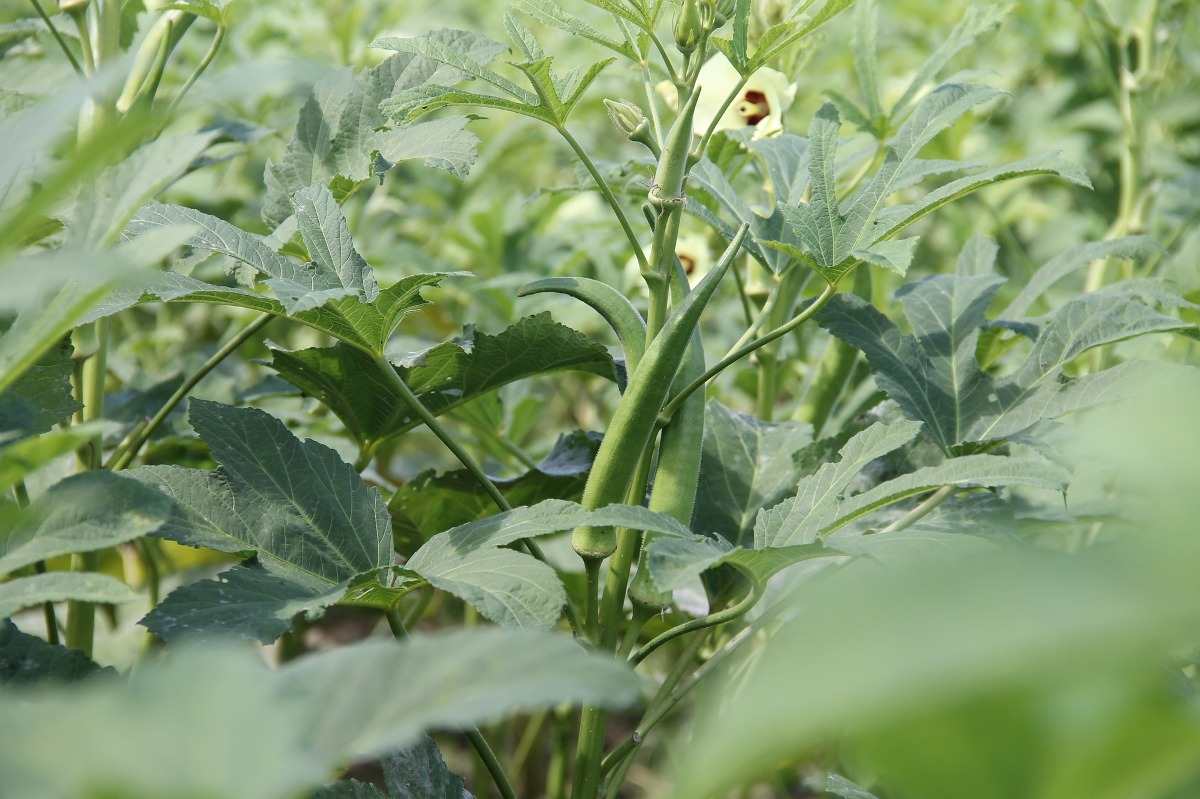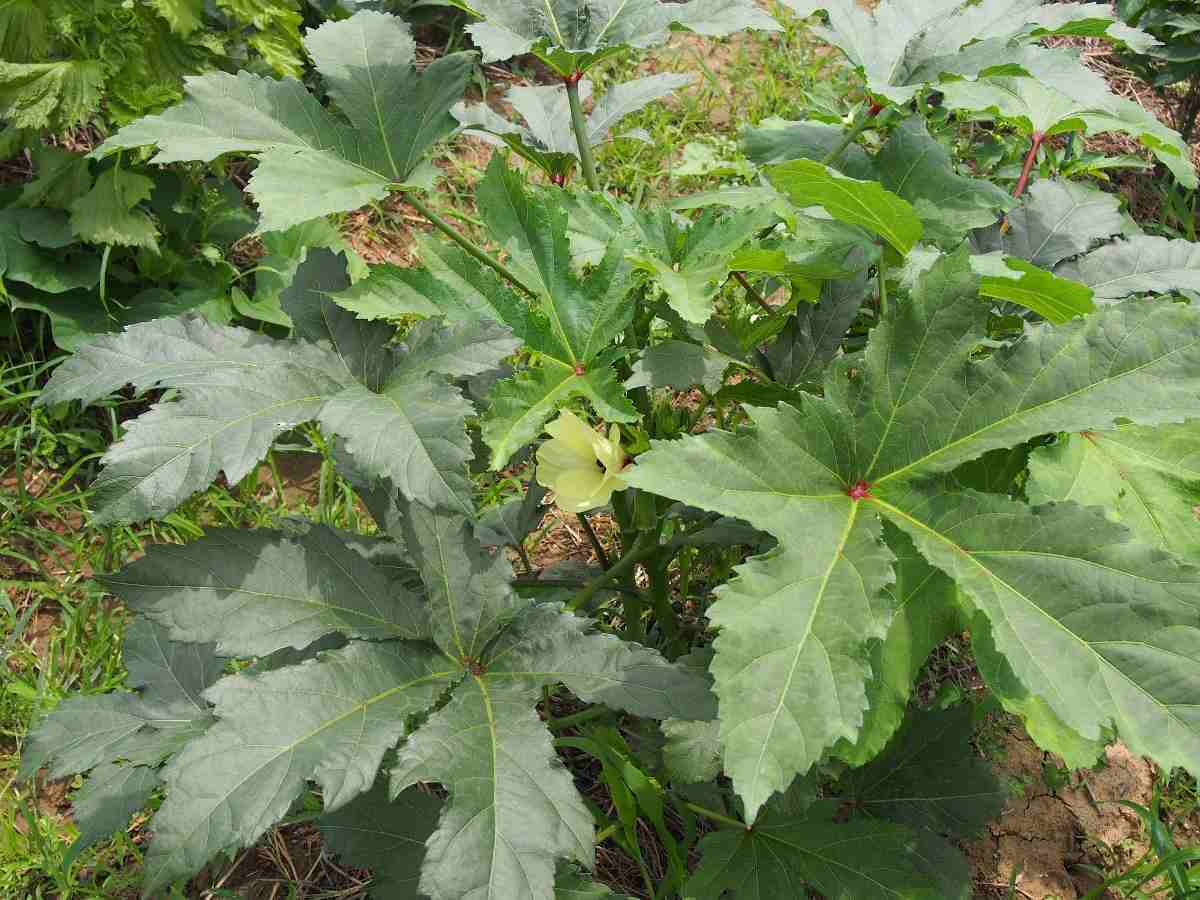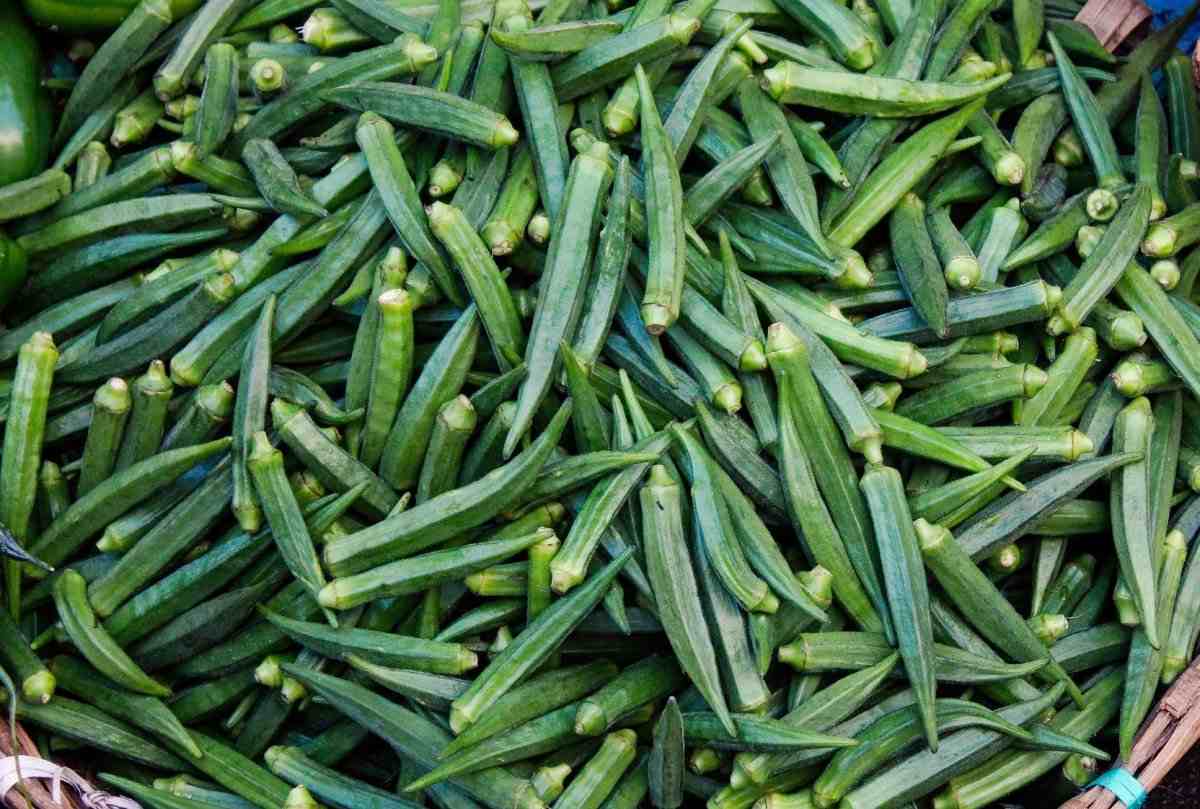Introduction to Organic Okra farming
Okra is one of the major vegetable crops of India and it is also called Lady’s finger and Bhendi. Okra is a tropical vegetable and requires a long, warm, and humid growing period. It grows even at an altitude of about 1,200 m. Okra thrives well in hot humid areas and is well suited for tropical and subtropical regions. Temperatures between 24°C and 28°C are preferred for normal growth and plant development. The seeds do not germinate below 20°C and the crop is sensitive to frost and will not thrive when there is a continuous cold spell. Higher temperatures help in faster plant growth though they can delay fruiting. However, high temperatures are not favorable and beyond 40 to 42°C, flowers drop, causing yield loss. Let us now get into the details of organic Okra farming practices.
A step by step guide to Organic Okra farming practices

The compost prepared from organic materials using earthworms is a low cost that has higher levels of NPK (nitrogen, phosphorous, and potassium) in available form, micronutrients, enzymes, and growth regulators. Though, neem cake is a potential source of organic manure. Then, that improves the organic matter content of the soil, helping improvement in soil texture, water holding capacity, soil aeration for better root development. Wood ash is a residual material formed during the conversion of biomass to electrical energy by wood-burning power plants. It is obtained from the combustion of wood and it can be related to fly ash since fly ash is obtained from coal, which is fossilized wood.
Organic farming involves locally and naturally obtainable organic materials to meet the production system without endangering our precious natural resources. Organic farming is an ecological production management that promotes and enhances biodiversity, and soil biological activity. Organic fertilizers such as vermicompost, FYM, organic manure, neem cake, and wood ash were applied 10g each at the topsoil of the pots.
For good seed germination, optimum soil moisture and temperature level between 25C and 35C are best. Beyond this range, delayed seed germination is observed and some seeds may not even germinate.
The basic concepts behind the Organic Okra farming are;
- It concentrates on building up the biological fertility of the soil so that the Okra crops take the nutrients they need from the steady turnover within the soil nutrients produced in this way are released in harmony with the needs of the Okra plants.
- Control of pests, diseases, and weeds is achieved largely by the development of an ecological balance within the system and by the use of bio-pesticides and different cultural techniques such as crop rotation, mixed cropping, and cultivation.
- Organic farmers recycle all wastes and manures within a farm but the export of the products from the farm effects a steady drain of nutrients.
- In a situation, where conservation of energy and resources is considered to be important, community or country would make every effort to recycles all urban and industrial wastes back to agriculture and the system would be only being small inputs of new resources to “top up” soil fertility.
Different varieties of Okra
Green fruited – Pusa Sawani, Kiran, Salkeerthi, Susthira, and Arka Anamika
Red fruited – Co-1, Aruna
Yellow vein mosaic resistant /tolerant varieties – Arka Anamika, Arka Abhay, Susthira, P7, and Varsha Uphar (all green fruited).
Soil organic matter for Okra production
The Okra crop is adapted to a wide range of soils from sandy loam to clayey loam. But due to its well-developed tap root system light, well-drained, loose, friable, and well-manured loamy soils are preferred. A pH level between 6–6.8 is ideal. Before sowing, enrichment with organic manure is needed for all soil types and Okra can also be grown in mild salt-affected soils.
Okra grows well in ordinary garden soil. But the plants will grow best and produce more in well-drained, fertile, and loam soil. Before planting Okra seeds or transplanting, prepare the soil by mixing organic fertilizers. You can use aged manure, compost, and bagged organic fertilizer. Fertile soil is the basis of organic farming. Healthy soil with good cropping patterns, crop residue management, and crop rotation can sustain optimum production levels over the years without any loss in soil fertility. Organic farming envisages a comprehensive management approach to develop soil health, the ecosystem balance of the region, and the quality of produce. And it includes all agricultural systems that promote environmentally sound production of food and fibers. Then, these systems take local soil fertility as a key to successful production by respecting the natural capacity of Okra plants; they aim to optimize quality in all aspects of agriculture and the environment.
The seed rate and treatment in Organic Okra farming
The Okra seed rate is 20 kg/ha for the summer crop sown in January–February and 8-10 kg/ha for Kharif crop.
For the summer crop, the seeds must be soaked in water for 12 hours before sowing. The Okra seeds can be treated with sweet flag rhizome extracts or cow urine solution (diluted with water in 1: 5 ratio) for 30 minutes before sowing. Then, this gives resistance against several bacterial and fungal diseases.
Seeds can be treated with cow dung solution (that means Beejamrut/Jeevamrut/Amrut Pani/Panchagavya) for 4–6 hours after soaking in water for 8 hours. The Okra seeds can then be dried in shade and sown.
Okra seed spacing or Okra plant distance/spacing
Spacing differs for different plant varieties and hybrids. The seeds must be sown on ridges 30 cm apart. The spacing between the two ridges should be maintained at 45 cm. For branching and robust types, a planting distance of about 60 cm between rows and 30 cm between plants is ideal. For hybrid varieties, the spacing adopted is 75 x 30 cm. Packaging of Okra seeds in polythene cover (700 gauges) increases the storage life up to 7 months and seeds treated with Trichoderma and Pseudomonas can be stored up to 5 months.
Organic manuring and fertilization in organic Okra farming
The fertilizer dose depends upon the fertility of the soil and the amount of organic manure applied to the Okra crop. About 20 to 25 tones/ha of FYM(farmyard manure) is mixed at the time of land preparation. Normally, the application of 100 kg N, 60kg P, and 50 kg K is recommended for optimum yield.
Fertilizers can be applied by opening up a deep narrow furrow on one side of each sowing ridge. Generally, nitrogen fertilizers like urea, calcium ammonium nitrate (CAN), and ammonium sulfate must be used for this crop.
For hybrid varieties, the recommended dose is 150 kg N, 112 kg P and 75 Kg K. Out of this dose, 2 5 2 30% of N and 50 % of P and K is applied as a basal dose. Remaining 50% of P and 40% of N and 25% of K is applied as a first top dressing 4 weeks after sowing. A balance quantity of 30% N and 25% K is applied as a second top dressing 7 weeks after sowing.
Topdressing can be done at 10 to 15 days interval with any one of the following;
- Soil application of fresh cow dung slurry by 1 kg/ 10 liters (50 kg/ha)
- Application of biogas slurry @ 1 kg/10 liters (50 kg/ha)
- Application of cow’s urine 500 liters/hectare (8 times dilution)
- Application of Vermiwash-500 liters/hectare (8 times dilution)
- Application of Vermicompost – 1 tonnes / hectare
- Application of groundnut cake1 kg/10 liters
- The foliar spray could be given with supernatant solution of cow dung slurry/vermiwash/ cow’s urine up to flowering.
You don’t want to add additional fertilizers if you have applied already while preparing the soil. Although providing the Okra plants with additional nutrients will be good. And you can use organic fertilizers such as compost tea during the growing period. You can also side-dress with compost every 3 to 4 weeks.
Pests and disease management in Organic Okra farming
You should not miss this: Plant Nursery Project Report for Bank Loan in India.

Insects and diseases are a major threat to Okra cultivation and bring about a considerable loss in crop yield. A major part of the cultivation cost is incurred for Okra crop protection. A list of major pests and diseases in Okra is given below and also given organic control measures;
Shoot and fruit borer
This is one of the common pests in cotton and attacks a large number of malvaceous plants. Infestation and damage to Okra crops are more in summer.
Symptoms – The larvae bore into tender shoots and then move downwards, creating a tunnel inside. The growing points are affected and thus side shoots may arise. Then, the affected shoots wither and droop. The caterpillars bore into the buds, flowers, and fruits and feed on the inner tissues. The damaged flowers fall off and affected pods are malformed.
Management
- Sowing seed in the first week of June is ideal to avoid damage of shoot and fruit borer during the rainy season.
- Summer plowing must be done to destroy bollworm pupae.
- Spray ginger, garlic, and chili and Sida Acuta Kashayam.
Leafhoppers
Symptoms – The nymphs and adults suck the sap from the undersurface of the plant leaves and inject toxic saliva into the plant tissues. The affected plant leaves first turn yellow, then brick red, before they become brittle and fall off. In cases of severe infestation, the fruits are affected. Climatic factors such as cloudy weather play an important role in the population build-up.
Management
- Install yellow sticky traps by 30/hectare
- Spray about 5% neem seed kernel extract of ginger, garlic, chili extract, or Sida acuta extract.
Fruit borers
The larva feeds on the foliage and when the tender leaf buds are infested, symmetrical holes or cuttings are seen when unfolded.
Management
- Adopt summer plowing to destroy bollworm pupae and place 15–20 bird perches per hectare. This invites predatory birds
- Mix one kilogram of fenugreek flour with 2 liters of water and keep aside for 24 hours. Then add 40 liters of water to the mixture and spray in the 1-hectare area. This ensures fifty percent control within 7 days.
- Prepare an herbal pesticide by boiling 4 kg of Aloe vera, 500 ml of neem oil, and 500 gm of tobacco powder in 20 liters of water. Boil the contents for 3 to 4 hours until it reduces to one-fourth of the original volume. Allow it to cool, add 50 gm of soap nut seed powder and mix thoroughly. Dilute 100 to 150 ml of this filtrate in 15 liters of water and spray.
- Install pheromone traps by 8 per hectare. Spray 5% neem seed kernel extract or Andrographis Kashayam or 5 leaf extract to kill the early stages of the larvae.
- Use biocontrol agents like Trichogramma by 50,000 eggs/hectare six times at weekly intervals.
Organic method to kill bugs on Okra plants
Flea Beetles
Flea beetles are tiny, dark beetles that jump like fleas and chew small, round holes in Okra plant leaves. Mix about 3 cups of kaolin clay in 1 gallon of water in a garden sprayer, and spray all Okra plant surfaces to coat the plants. Reapply the solution after rainfall or every 7 to 21 days. Wear gloves and protective clothing when mixing and then applying the solution.
Aphids
Aphids are tiny pear-shaped insects that suck plant juices, often cluster on the undersides of Okra leaves, or eat the tender new growth of the plants. The first defense against aphids is to cover young Okra plants with floating row covers. For heavy infestations, apply organic, ready-to-use insecticidal soap to the plants at 5 to 7-day intervals. Do not apply insecticidal soap when the temperature exceeds 32°C.
Stinkbugs
Stinkbugs are large, shield-shaped, brown insects that leave depressions and blemishes on Okra pods and plants. Monitor Okra plants for these pests each morning, and remove the insects by hand while wearing gloves and a long-sleeved shirt. Then, drop the stinkbugs into a pail of soapy water, which will kill them. Stinkbugs are drawn to weedy areas. Therefore, remove garden weeds, and clean up nearby weedy areas.
Earworms
Corn earworms caterpillars that feed on leaves and pods occasionally damage Okra plants. Check the tops and bottoms of Okra plant leaves daily, and handpick the small caterpillars. For heavy infestations, spray the Okra plants with a solution of 1 to 2 teaspoons of bacillus thuringiensis, or Bt, concentrate per 1 gallon of water. Then, this organic insecticide causes caterpillars such as earworms to cease feeding and die within a few days. Repeat the application every 3 to 14 days as needed, following the product manufacturer’s safety recommendations for application. As with spinosad, use Bt only when necessary, and apply it in the early morning or late evening, when beneficial insects are less to be present than at other times of the day.
Diseases of Okra plants
Powdery mildew
A fungal disease, characterized by grey-colored powdery growth on both the upper and lower surface of the plant leaves. It severely affects the yield of the Okra crop but can be controlled by applying 10% lime water
Minor diseases
- Fusarial wilt
- Damping-off
- Fruit rot
- Leaf spot
- Anthracnose
General management of diseases is;
- Spray mint leaf extract (250 grams of leaf powder in two liters of water)
- Spray 10% cow urine thrice at 10 days’ interval.
- Spray 5% neem seed kernel extract.
Harvesting and a yield of Okra

Depending upon the variety and season, the harvesting period varies between 45 and 65 days after seed sowing. The size of the pods and the stage at which they are harvested vary with the plant variety or hybrid and market preference.
The Okra fruits are handpicked; hand gloves or cloth bags are used to protect fingers. The fruits can be harvested on all alternate days and early harvesting results in low yields of tender fruits with a short shelf life. Flowering and fruiting intensity reduce in Okra plants which are not regularly picked for tender pods.
Crop yield varies greatly depending upon the variety and season of cultivation. On average, Okra yields 7.5 to 10 tonnes/ hectare and the yield of hybrid varieties ranges from 15–22 tonnes/hectare.
In case if you are interested in this: Growing Okra Hydroponically from Seed, Planting, Care.